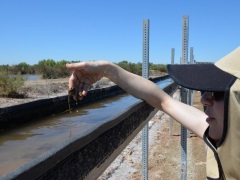Features
Ironic algae
Date: 2017-08-12 12:09:44.0
Author: Jon Evans

Sandia chemical engineer Anthe George
with a handful of algae growing in the
SABRE project floway system.
Photo: Jules Bernstein.
In an ironic twist, one solution to toxic algal blooms in lakes and other bodies of water could well be more algae. Sandia National Laboratories in the US is testing a novel technology that cultivates algae on the nutrient-rich water that can encourage the growth of such toxic blooms in open bodies of water. This approach both cleans the water by removing the nutrients, thus preventing the growth of toxic blooms, and also produces algae for conversion into biofuels and other chemicals.
Toxic blooms of algae are the result of agricultural runoff from fields – containing high concentrations of nitrogen and phosphorus from the application of artificial fertilizer – entering streams and rivers that feed into lakes and other bodies of water. These nutrient-rich waters stimulate the growth of large quantities of algae, producing the blooms. The problem comes when the algae in these blooms die, because they do so in large quantities that use up a lot of the oxygen in the water as they decompose, creating low-oxygen ‘dead zones’ that can kill much of the fish.
Large toxic algal blooms regularly appear in bodies of water surrounded by agricultural land, including Lake Erie, the Gulf of Mexico (see Beware the dead zone) and the Salton Sea, a 350-square-mile lake in Southern California. Now, under a project called Salton Sea Biomass Remediation (SABRE), Sandia National Laboratories is testing a technology developed by US company HydroMentia Technologies for preventing the formation algal blooms while also producing algae for use as feedstocks for biofuels and biochemicals.
Known as the ‘Algal Turf Scrubber’, the technology is built around a 900-foot metal trough, looking much like a freestanding roof gutter. Water from one of the tributaries leading to the Salton Sea is directed into this trough, and then kept flowing through it by a solar-powered pumping system developed by Sandia. This water is rich in nitrogen and phosphorus from the runoff from surrounding fields and so would promote the growth of algal blooms if it reached the Salton Sea. Instead, it is used to promote the growth of algae in the troughs.
The growing algae remove the nitrogen and phosphorus from the water, cleaning it, and this cleaned water is then directed back into the tributary. Meanwhile, the algae is regularly removed from the troughs for conversion into biofuels and biochemicals.
This set-up overcomes many of the problems that bedevil existing algae cultivation systems, which are mainly based on growing the algae in raceway ponds. These are expensive to build and maintain, and require regular supplies of fertilizer and water. In contrast, the Algal Turf Scrubber is cheap to build and maintain, and all the requirements for fertilizer and water are provided by the tributary.
"There's water and then there's water," explains Sandia biochemist Ryan Davis. "We've shown that we can grow algae in turf scrubber systems using water full of nasty components. And it still thrives."
Raceway ponds can also suffer from crashes, in which pest infestations kill off a large proportion of the algae; around 30% of production in raceway ponds can be lost each year due to such crashes. These shouldn’t be as much of a problem for the Algal Turf Scrubber, because it grows algae that are native to the local area, which should have naturally built up a certain amount of resistance to local pests.
Although the Sandia researchers have only been testing the technology for a few months, they’ve already obtained some promising results. “The early results we're already getting from the Salton Sea appear to be superior to results from similar algae systems,” says Davis.
Other research being conducted at Sandia could make these results even more promising. Using small indoor raceway ponds, Sandia researchers are currently testing numerous species of algae to find out which are best at resisting pests and producing oil. The best-performing species could then be mixed in with the naturally hardy species already growing happily under the California sun.
The views represented here are solely those of the author and do not necessarily represent those of John Wiley and Sons, Ltd. or of the SCI.
Displaying 5 keywords used to tag this article:
- Contenuto carrello : replica profes
- Copy Panerai Watches Black Dial Bro
- Moncler Outlet | Дешевое Mon
- Montblanc Грета Гарбо :
- Moncler Women :
